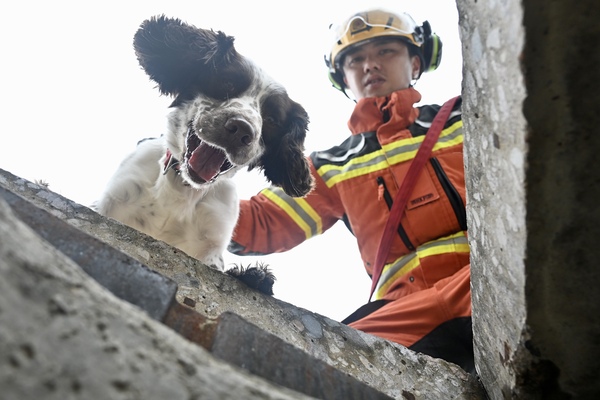Lending A Rescue Paw

In 2021, the Fire Services Department (FSD) successfully bred its first batch of working dogs in collaboration with the Customs & Excise Department. Among them are Umi and Uma, who are now two years old.
As an essential part of the FSD’s Search & Rescue Dog Team, the pair have already saved many lives. In February this year, Umi and his teammate Twix helped at the Türkiye earthquake zone and rescued four people.
In July last year, Umi and Uma were deployed together to search for a missing hiker on a mountain in Clear Water Bay. They also conducted searches after a No.3 alarm fire broke out in a warehouse in Fanling last August.
Umi's handler Chan Chu-hong believed that Umi is perfect as a search and rescue dog.
"The English Springer Spaniel has a keen sense of smell. Coupled with its agility, it can cover large areas and detect the source of human scent in no time, " said Mr Chan.
New search methods
Operations in mountain areas is a training focus for the canines.
The number of mountain rescues in Hong Kong rose from 242 in 2018 to 1,014 last year.
In the past, search and rescue dogs would carry out large-scale searches to detect human scents, but it was energy consuming due to the absence of a specific target scent.
Because of this, the department changed things round and employed a new training technique early last year that focuses on tracking specific odours.
“During actual rescue operations, we visit the missing people's home and collect their scents, such as those from pillowcases, shoes or clothing for the dogs to track,” Mr Chan explained.
Enhanced training
Search and rescue dogs regularly practise their skills at an urban search and rescue training ground at the Fire & Ambulance Services Academy.
The Department said the canines had to overcome environmental challenges such as distracting food smells, the scent from different people's clothing, heavy machinery and even fire at the quake-stricken areas in Türkiye. The experience has helped to strengthen their regular training.
“We can enhance our training by simulating a more realistic collapsed site environment, understanding the potential dangers in actual disaster areas and thus develop more suitable search and rescue strategies,” said Mr Chan.
Well bred
The Fire Services Department currently has six search and rescue dogs, of which Uma and Umi were bred and trained in Hong Kong, while the other four were born and trained in other places.
The Department believes that in-house breeding can better meet their training needs.
"The puppies received basic training and socialisation training in a game-based mode at around two months old to help them develop a brave and friendly character. They could also adapt to the weather and terrain of Hong Kong," Mr Chan said.
The department hopes to breed a new generation of search and rescue dogs in the future to help the people of Hong Kong.
New Hub Helps Green Tech To Flourish
Last month, the Hong Kong Science & Technology Parks Corporation, or HKSTP, transformed its InnoCentre in Kowloon ... Read more
MICE Tourism Gains Momentum
Ballroom inspections and mahjong sessions may not be what automatically springs to mind when you consider Hong Kong’... Read more
Game Startups Reach New Level
The global video game industry is highly competitive, requiring effective marketing for success. The Hong Kong Game En... Read more
Breast Milk Donations Save Lives
Last April, Ida Chan welcomed her son into the world. He was born a kilogramme lighter than expected, and Ida decided ... Read more
HK Reaches For The Moon
The beauty and mystery of the Moon have captivated the human imagination for millennia. Channelling that fascination i... Read more
Creating Disability-inclusive Jobs
Nestled in the Museum of the War of Resistance & Coastal Defence, Madam Hong Cafe enjoys the spectacular views of ... Read more

